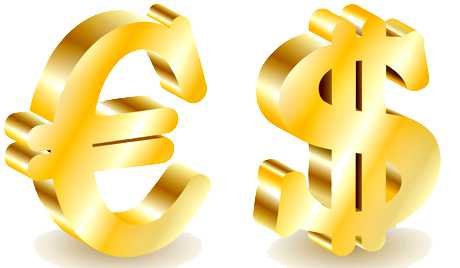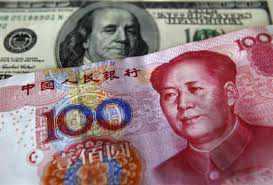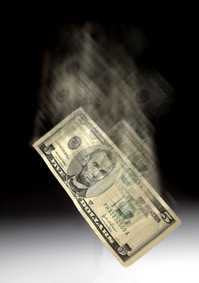[This article published in: isw report 83/84 “China crisis as a chance” is translated from the German on the Internet,
The Yuan is completely undervalued and therefore harms the US economy. That is the aggressive reproach of the US government.
As long as US citizens could indulge their consumer orgy financed by China’s credit, the US economy flourished somewhat and the Yuan exchange rate was hardly a theme. A scapegoat for the misery is now sought in the crisis with the highest US unemployment in decades. The “manipulated” and “artificially under-valued” Yuan price is the reason for the Chinese export success destroying jobs in the US and making difficult US exports to China.
First of all, no one can be certain or prove whether a currency is under- or over-valued because there is no objective criterion or standard. Even exchange rates that supposedly are freely formed on the market are politically manipulated by interventions of states, state debt acceptance and fixing key interest rates. These exchange rates are distorted by market forces and by potent financial speculator5s who speculate on a devaluing or upgrading of the currency. Currency speculation is the main business of the financial fraudsters today.
Since the fall of 2008, the Yuan price has been bound in a firm relation to the dollar and neither upgraded nor devalued. When exchange rates deteriorate in trade for the US, this means firstly the productivity-development of the US economy has worsened compared to China. China cannot be punished for that. Whether the foreign trade situation would improve substantially for the US with an upgrading of the Yuan is doubtful. The export miracle hoped for by the US did not occur during a first upgrading phase between July 2005 and June 2006. Although the Renminbi rose 21 percent compared to the dollar, the US balance of payments deficit in trade with China hit a record high in this time period at 39 percent. (The Yuan was upgraded around 58% between January 1994 and the end of 2010.)
With the beginning of the financial crisis, the Chinese government suspended the gradual adjustment. Its currency should not fall in the turbulences of the financial crisis which at the start hit the export industry hard and cost millions of jobs. 67,000 businesses of the export industry declared bankruptcy. Therefore the Chinese government saw no need for additional action in the matter of upgrading. The Yuan was firmly coupled to the US dollar at a rate of 6.83.
The value of the Yuan is not the cause for the US trade and balance of payments deficits. The reasons are the high state indebtedness (armaments/wars and tax gifts to the rich) and the indebtedness of private households caused by stagnating or declining real incomes of the masses (income distribution in favor of profits and interest income). In the words of Stephen Roach, Asian president of Morgan Stanley, “If the US (state and private households) continues to save, the US will be less dependent on financing by Chinese savers. American consumers would no longer overspend and buy cheap Chinese goods. Which came first, the surplus or the deficit? Did the Chinese development strategy force Americans to blow their savings? Or did American greed, living beyond their means, force the Chinese to supply them with cheap capital and bargain-priced goods?” (HB. 4/14/2010). Over 60 percent of the articles offered by the largest US discounter Walmart come from China. The products are voluntarily acquired by Americans. If China did not offer them, other cheap producers would quickly take over this role. The US has a trade deficit with 90 countries. The US must accuse all these countries of currency manipulation as in the case of China. Investors in developing countries urged a firm dollar-bond early on. They wanted to prevent profits transferred from their countries from losing value.
The essential reason for the imbalances in US trade is that the American economy is no longer competitive in relation to these 90 countries. In the course of militarization (imperial overstretch, “Homeland Security” mania) and financialization, the US economy increasingly became a waste economy with rising deficits in infrastructure and education. In addition, a process of de-industrialization has been carried out in the US in the last decades. US transnational corporations have largely shifted their production sites abroad, above all to China. Stephan Roach explains: “US corporations produce cheaply in China and thus their profits, stock prices and the wealth of many shareholders are blown up. This was basically an upward spiral for Americans driven by virtual purchasing power” (HB, 4/14/2010). What previously was a manifestation of the imperial power and strength of the US, namely living at the expense of the rest of the world, now suddenly changes into weakening and consumption of the economic substance.
“GET TOUGH ON CHINA”
The production transfers to China have led to exporting industrial goods with low or medium technological standards by US or other western corporations from China to the US. US high-tech products that China would like to import are subject to the politically-defined US embargo. 20 product categories are blocked for export to China. In 2001, 18.3% of Chinese high-tech imports came from the US. Through the restrictions of the Bush administration, this share fell to eight percent in 2008 (chd, 3/6/2010).
In the US, the debate around the Yuan among economists is very controversial. While Nobel Prize winner Paul Krugman accuses China of keeping the Yuan price artificially low and urges “getting tough on China,” Nobel Prize winner Robert Mundell does not agree. Nobel Prize winner Joseph Stiglitz urges loosening high-tech restrictions to facilitate a more even trade balance (cf. chd, 3/22/2010). The economist Peter Schiff, well-known for his exact prediction of the 2008 crisis, writes: “It is all a PR-maneuver that our leaders could `get tough’ with the Chinese. They know very well where their bread is buttered. They depend on the Chinese buying our debts and providing our citizens with cheap products that our unproductive economy cannot produce. When China buys our debts, it uses its own savings. To purchase a trillion dollars in US Treasury bonds, the Federal Reserve must increase our money supply a corresponding amount leading to a sharp decline of the dollar” (chd, 3/20/2010). Schiff warned that a falling dollar would lead to consumer prices rising by leaps and bounds, to quickly soaring interest rates and to a collapse of US living standards. This would mean the end of Krugman’s “Get tough on China” policy, he added. Other experts point out that China has contributed enormously to the revival of the global economy and not only finances US debts and supplies US consumers with cheap consumer goods. Finally China has reduced its balance of payments surplus in the last three years by rapidly increasing imports. It decreased imports more slowly than exports in the crisis year 2009.
The reproach of currency manipulation is not new and is always raised by Americans against states when they are at as competitive disadvantage in trade policy. In 1971 the US government accused Germany and Japan of currency manipulation and forced them to upgrade their currencies. On August 15, 1971 President Nixon put a temporary surcharge on imports. The remark of Nixon’s Treasury secretary John Connally, full of arrogance of power, was the monetary motto of the superpower: “The dollar is our currency but your problem.” In the 1980s when the US had gigantic deficits in trade with Japan, Washington forced the Asian power to drastically upgrade the Yen in the 1985 Plaza agreement. The US balance of trade did not improve as a result. Billions in speculations streamed to Japan and pumped up the trade- and real estate bubbles until they burst and gave the country its “lost decade.”
China will not fall in the same trap as Japan at that time. Washington wants to force Peking to abrupt upgrading through sanctions and a trade war if necessary. The past concessions of the Chinese leadership are not enough for the US government. China recently suspended the dollar bond just before the G20 summit in June 2010 in Toronto. Since then, it couples its currency to a basket of currencies that better reflects trade relations. The Euro will be given more weight in setting the Yuan price. The Yuan was slightly upgraded three percent from July to the mid-November G20 summit in Seoul but that was not enough for the US government.
On September 29, 2010 the US House of Representatives passed a bill against “currency manipulation” directed first of all against China. It can first become law after passage by the Senate and President Obama’s signature. Afterwards penal duties and other sanctions will take effect quasi-automatically. The American Chamber of Commerce in China representing 1200 firms appealed to the Senate to kill the bill. As reasons, it said significant US job growth would probably not be generated by the law and American exporters would be hurt. “Censuring China will not help the US economy. This legislation could cost American jobs,” the president of the Chamber of Commerce, John D. Watkins, declared (quoted according to chd 10/1/2010).
CURRENCIES AS WEAPONS
Now and then the monetary skirmish between the US and China threatens to change suddenly into a world currency war. The US has a trade deficit problem with many countries, with the export powers Germany6, Japan and not only with China. They urge these countries to do more in expanding their domestic markets and thus equalize their trade balances and reduce the imbalances in world trade. At the same time the US manipulated its currency downwards when the US Federal Reserve after the G20 summit announced and implemented buying $600 billion in US Treasury bonds in the next six months. This measure is tantamount to starting up the money printing machine.
A cheapening or devaluation of the dollar will make difficult exports to the US and will favor US exports. For want of mass purchasing power on the domestic market, all capitalist metropolis countries want to export out of the crisis and compensate their weak domestic demand through greater exports on the world markets. Only Germany was successful with this strategy. Since there will be no global import vacuum any more4 like the United Consumer States of America, the trade conflicts intensify and the danger of a devaluation-race threatens like the worldwide economic crisis 80 years ago.
Presently the US is mired in a credit crunch like Greece and Ireland – only in other dimensions and with other options. Annually it must fork out $500 billion for its gigantic debt mountain. The US state debt-maker now has an additional problem. Its most reliable and largest creditor turns off its money-pump. For a year Peking has not purchased any US bonds. Within a year, the Chinese reduced their portfolio in treasuries from $938 billion (at the end of September 2009) to $884 billion (at the end of September 2010), that is $54 billion (GT 11/17/2010; chd 5/19/2010). Previously from 2008 to the fall of 2009, they purchased $17 billion of state bonds every month. We can o9nly puzzle over the motives of the Chinese. Firstly they buy Euros and other currencies for reasons of risk-scattering to partly offset the dollar decline. That is also the reason for the fluctuations in holdings of Treasuries on the backdrop of a downward trend. Secondly, it seems to be a certain answer to the China-bashing driven by the US government for a year in the question of Yuan upgrading. In the meantime, China has become confident enough to strike back with the weapon of the economy. The USA again tries to make a virtue out of its money-distress and recoin it to its advantage.
With the additional dollar flood, the upgrading pressure on the currencies of threshold countries increases which could again limit their export-capability to the US. More “hot money” sloshes around on their stock- and real estate markets. The danger of bubbles in these countries increases. Like the Japanese Yen, the dollar becomes the profitable source for carry-traders, golden times for US and international financial capital. If the bubbles on the stock exchanges and real estate markets of threshold countries burst, these countries pay for the US debt policy.
The dollar flood brings the advantage for the US that its foreign debts are devalued as the dollar is devalued. Greece and Ireland would be afraid to balance their deficits with Euros they print themselves. Everything is allowed the powerful.





